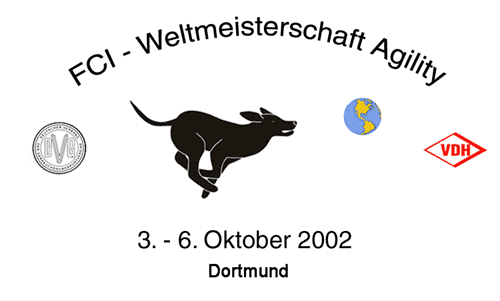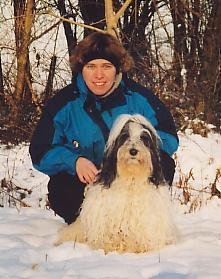Germany may have
started agility later than many European countries, but it's catching up - fast!
 The first contact most Germans had with
Agility was in 1990 when the World Dog Show was held in Dortmund (which later
hosted the 2002 Agility World Championships). Gabi Stumpf was
fascinated and decided, then and there, that she was going to do that, too. Many years came to
pass before this became reality. The first contact most Germans had with
Agility was in 1990 when the World Dog Show was held in Dortmund (which later
hosted the 2002 Agility World Championships). Gabi Stumpf was
fascinated and decided, then and there, that she was going to do that, too. Many years came to
pass before this became reality.
At that time in our area there were
only very few clubs, or should I say almost none, that offered Agility. Other areas of Germany
Agility was offered already for several years, but here it is only in the last five years that
Agility Clubs popped up like mushrooms. In the beginning it was pushed very much by the German
Shepherd Dog Association. All other dog sport associations offered Turnierhundesport (this
sport exists only in Germany).
We have several dog
sport associations, which is also the reason why we still have two German Championships.
Many dog handlers in
Germany have their Agility knowledge from foreign countries. The have visited seminars held by
Astrid Steiner, Marco Mouen (Swiss), Emil Verfoort, Hinky Nickles, Alex Kimps (B), Henk and
Itje Postman (NL), John Gilbert, Don Cooper (GB), Manuela Nassek (A) and others. The main
thought, to learn from friends outside of Germany, was to profit from the knowledge they
achieved already since they have been doing Agility for so many more years. Why test different
methods again when you can take over the results already.
In Germany it is
mandatory to do a kind of Obedience test called Begleithundeprüfung, before you can start doing
Agility. We have five levels:
-
Beginner
-
Senior
-
A1
-
A2
-
A3
The Beginner is not
an official competition class and is also not documented in the performance record of the dog.
Since 2002 you must achieve three excellent judgings with no faults and for these three
excellent results you need to have at least two different judges to ascend to the next Agility
level.
It is very sad that
Agility in Germany becomes more and more a sport for Border-Collies and Shelties only. When
today someone buys a new dog it is very seldom another breed anymore.
 Also
little dogs in Germany are a little discriminated and often only earn a tired smile. This is
because the tournaments are rather small compared with tournaments in other Countries. Normally
there are about 100 teams through all categories. So this means that there is only very little
competition in some grades. The majority of the teams you will find among the large dogs and
here again most of them you will find in level A1. The midi class is most of the time the
smallest group, there it can happen that you have no competitor at all. A judge is not allowed
to judge more than 100 starters per day. The tournaments are held on club property that is in
most cases not very big and, therefore, only one ring can be built. This makes it difficult
to have more than 100 competitors. It also would be more costly to have a second judge. Every
once in a while you will find a tournament with 200 participators, but that is an exception. Also
little dogs in Germany are a little discriminated and often only earn a tired smile. This is
because the tournaments are rather small compared with tournaments in other Countries. Normally
there are about 100 teams through all categories. So this means that there is only very little
competition in some grades. The majority of the teams you will find among the large dogs and
here again most of them you will find in level A1. The midi class is most of the time the
smallest group, there it can happen that you have no competitor at all. A judge is not allowed
to judge more than 100 starters per day. The tournaments are held on club property that is in
most cases not very big and, therefore, only one ring can be built. This makes it difficult
to have more than 100 competitors. It also would be more costly to have a second judge. Every
once in a while you will find a tournament with 200 participators, but that is an exception.
To walk and
learn a parcours (course) you have five minutes on each run. The tournaments will start with A1, A2
and A3 in the afternoon the Jumping will take place. But you never know whether they
will start with mini
or maxi dogs, so you must always stay and wait not to miss your turn.
Up until 2001, the
first three winners in every category would get a trophy. But because of the category changes
into Mini, Midi and Maxi groups which took place last year now only the winner of the mini and
midi group will get a trophy. Sometimes they have also other prizes like little Agility
obstacle models.
At each tournament
you are only allowed to start twice. The A-Run and the Jumping. In my beginner times of Agility
there was also a game offered at the end of the day but this is totally “out” now. As soon as
the jumping is finished everybody starts to pack up and get ready to go home. But because we do
not get our performance record of the dog back until after the winners are announced, everybody
has to stay until the end. Which some handlers really regret, if they have a long trip home.
The climax of
the German-Agility was when Silvia Vaanholt and the German team finished 3rd in 1999
at the World-Championship in Dortmund. We had hoped to be successful this year too, but other
countries have also good Agility competitors.
 About
the author...Gabi Stumpf About
the author...Gabi Stumpf
It all started with the death of my
mother and me having to keep my promise to look after her Tibetan terrier Ory.
That is now
quite a few years ago and hasn't always been easy.
Even though I looked after Ory from the beginning he
didn't listen at all and I decided to do something for his education. So I enrolled in a basic
obedience course and became hooked on dog sport.
The first time I saw agility was at the world show in
Dortmund. I was fascinated and decided, you are going to do that too. Many years
would pass
before this became reality.
At that time there was no club near me doing this sport
and so I started with tournament dog sport, but in my mind I always thought "agility".
I
trained 4 years in tournament dog sport, but at some stage it became boring. So the old idea
came back into my mind...you did really always wanted to do agility! I started a beginner
course. My illusion that Ory would learn everything in no time was quickly buried.
Everything was
easy...as long as it went straight on!!! he knew that from this. But turns or send on
I could
forget about. Slowly I learned more and more, took part and organised seminars and each
instructor gave me different hints. I just tried everything until I found my own style and
I
still don't know enough!!!
Unfortunately Ory and I had got lucky and made it to
A3,
we had many clear, but always with 1 or 2 seconds time faults. At that time the judges set
very tight times, fortunately that is different now.
in the meantime Ory also became a dancer.
He really still
started to learn a few dog dancing tricks at the age of 12. We also made a fantastic appearance
at the speciality breed show for Tibetan terriers to "fly on the wings of love" and even got to
be on television with this song in the program "time for animals". Ory still competed until 13˝ in senior agility.
Ory
is now 14 years and 9 months and his heart and bones are no longer the youngest.
It was a good
time with Ory. I am the lucky one who was able to take part in all sorts of dog sports with
him.
In the meantime I mainly instruct, but I have 2
borrowed dogs, a Spitz Klein, Mogly, with whom I do obedience and dog dancing and
Spitz middle,
Emil, who is about to discover with me that agility is the favourite hobby.
(Translated by Heidi Totesaut)
|